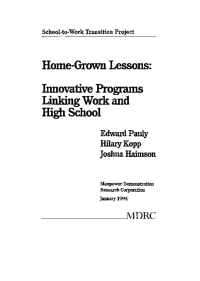Home-Grown Lessons
Innovative Programs Linking School and Work
In recent years, there has been a groundswell of policy interest in improving high schools by providing high-quality education that is directly relevant to the world of work, linked with work-based learning experiences provided by cooperating employers. The federal government, Congress, and many states and localities are working to create new school-to-work initiatives that can prepare a broad range of youth for post-secondary education and careers, while integrating school-based and work-based learning.
The basic rationale for these proposals is that, currently, three-quarters of the young people in the United States do not receive a four-year college degree. For them, high schools often provide weak preparation for post-secondary education and training, few opportunities to explore potentially rewarding careers, and little exposure to the skills that are required in an increasingly technical labor market. School-to-work programs are seen as a way to upgrade students’ education and build a highly skilled workforce that can successfully compete in the international marketplace. Policymakers are respondiong to these challenges by attempting to stimulate the creation of innovative school-to-work programs.
The report describes the efforts of pioneering U.S. school districts and employers that have built programs to help students make the transition from school to work. It presents their “home-grown lessons” — the discoveries made by educators and employers in 16 school-to-work programs in 15 communities’ (in 12 states), and the challenges they confronted.






